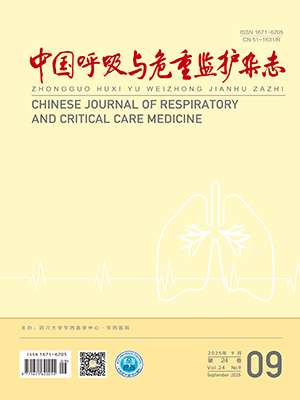| 1. |
Geetha D, Jefferson JA. ANCA-associated vasculitis: core curriculum 2020. Am J Kidney Dis, 2020, 75(1): 124-137.
|
| 2. |
Mohammad AJ, Mortensen KH, Babar J, et al. Pulmonary involvement in antineutrophil cytoplasmic antibodies (ANCA)-associated vasculitis: the influence of ANCA subtype. J Rheumatol, 2017, 44(10): 1458-1467.
|
| 3. |
嗜酸性肉芽肿性多血管炎诊治规范多学科专家共识编写组. 嗜酸性肉芽肿性多血管炎诊治规范多学科专家共识. 中华结核和呼吸杂志, 2018, 41(7): 514-521.
|
| 4. |
Zhou PN, Li ZY, Gao L, et al. Pulmonary involvement of ANCA-associated vasculitis in adult Chinese patients. BMC Pulm Med, 2022, 22(1): 35.
|
| 5. |
Włudarczyk A, Polok K, Górka J, et al. Patients with small-vessel vasculitides have the highest mortality among systemic autoimmune diseases patients treated in intensive care unit: a retrospective study with 5-year follow-up. J Crit Care, 2018, 48: 166-171.
|
| 6. |
Jennette JC, Falk RJ, Bacon PA, et al. 2012 revised International Chapel Hill Consensus Conference Nomenclature of Vasculitides. Arthritis Rheum, 2013, 65(1): 1-11.
|
| 7. |
Suppiah R, Robson JC, Grayson PC, et al. 2022 American College of Rheumatology/European Alliance of Associations for Rheumatology Classification Criteria for Microscopic Polyangiitis. Arthritis Rheumatol, 2022, 74(3): 400-406.
|
| 8. |
Robson JC, Grayson PC, Ponte C, et al. 2022 American College of Rheumatology/European Alliance of Associations for Rheumatology Classification Criteria for Granulomatosis With Polyangiitis. Arthritis Rheumatol, 2022, 74(3): 393-399.
|
| 9. |
Grayson PC, Ponte C, Suppiah R, et al. 2022 American College of Rheumatology/European Alliance of Associations for Rheumatology Classification Criteria for Eosinophilic Granulomatosis with Polyangiitis. Ann Rheum Dis, 2022, 81(3): 309-314.
|
| 10. |
Mukhtyar C, Lee R, Brown D, et al. Modification and validation of the Birmingham vasculitis activity score (version 3). Ann Rheum Dis, 2009, 68(12): 1827-1832.
|
| 11. |
Leacy E, Brady G, Little MA. Pathogenesis of ANCA-associated vasculitis: an emerging role for immunometabolism. Rheumatology, 2020, 59(Suppl 3): iii33-iii41.
|
| 12. |
Mohammad AJ. An update on the epidemiology of ANCA-associated vasculitis. Rheumatology (Oxford), 2020, 59(Suppl 3): iii42-iii50.
|
| 13. |
Li JN, Cui Z, Long JY, et al. The frequency of ANCA-associated vasculitis in a national database of hospitalized patients in China. Arthritis Res Ther, 2018, 20(1): 226.
|
| 14. |
Berti A, Dejaco C. Update on the epidemiology, risk factors, and outcomes of systemic vasculitides. Best Pract Res Clin Rheumatol, 2018, 32(2): 271-294.
|
| 15. |
Fujimoto S, Watts RA, Kobayashi S, et al. Comparison of the epidemiology of anti-neutrophil cytoplasmic antibody-associated vasculitis between Japan and the UK. Rheumatology (Oxford), 2011, 50(10): 1916-1920.
|
| 16. |
陈荣毅, 吴思凡, 俞文溯, 等. 一项单中心十年的血管炎住院病种流行病学资料分析. 复旦学报(医学版), 2021, 48(2): 162-168, 228.
|
| 17. |
Mercuzot C, Letertre S, Daien CI, et al. Comorbidities and health-related quality of life in patients with antineutrophil cytoplasmic antibody (ANCA) - associated vasculitis. Autoimmun Rev, 2021, 20(1): 102708.
|
| 18. |
Hassan TM, Hassan AS, Igoe A, et al. Lung involvement at presentation predicts disease activity and permanent organ damage at 6, 12 and 24 months follow-up in ANCA-associated vasculitis. BMC Immunol, 2014, 15(1): 20.
|
| 19. |
Mun CH, Yoo J, Jung SM, et al. The initial predictors of death in 153 patients with ANCA-associated vasculitis in a single Korean centre. Clin Exp Rheumatol, 2018, 36 Suppl 111(2): 65-72.
|
| 20. |
Chen M, Yu F, Zhang Y, et al. Clinical [corrected] and pathological characteristics of Chinese patients with antineutrophil cytoplasmic autoantibody associated systemic vasculitides: a study of 426 patients from a single centre. Postgrad Med J, 2005, 81(961): 723-727.
|
| 21. |
Solans-Laqué R, Fraile G, Rodriguez-Carballeira M, et al. Clinical characteristics and outcome of Spanish patients with ANCA-associated vasculitides: impact of the vasculitis type, ANCA specificity, and treatment on mortality and morbidity. Medicine (Baltimore), 2017, 96(8): e6083.
|
| 22. |
Kwon HC, Pyo JY, Lee LE, et al. Male sex is a significant predictor of all-cause mortality in patients with antineutrophil cytoplasmic antibody-associated vasculitis. J Korean Med Sci, 2021, 36(18): e120.
|
| 23. |
Pérez N, Gargiulo MLÁ, Suarez L, et al. Clinical characteristics and prognostic factors in an Argentinian cohort with ANCA-associated vasculitis. Medicina (B Aires), 2021, 81(2): 198-207.
|
| 24. |
Matsuda S, Kotani T, Suzuka T, et al. Evaluation of poor prognostic factors of respiratory related death in microscopic polyangiitis complicated by interstitial lung disease. Sci Rep, 2021, 11(1): 1490.
|
| 25. |
Smith R. Complications of therapy for ANCA-associated vasculitis. Rheumatology, 2020, 59(Suppl 3): iii74-iii78.
|
| 26. |
Tang S, Li X, Zhao KY, et al. Clinical characteristics and prognostic analysis of microscopic polyangiitis with diffuse alveolar hemorrhage. J Rheumatol, 2021, 48(3): 410-416.
|
| 27. |
Shi J, Shen Q, Chen XM, et al. Clinical characteristics and outcomes in microscopic polyangiitis patients with renal involvement: a study of 124 Chinese patients. BMC Nephrol, 2019, 20(1): 339.
|




